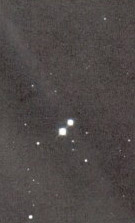Visual Binary Stars
Binary stars that can be visually resolved with the use of a telescope are called visual binaries. Clearly this designation depends upon the resolving power of the telescope used, but provides a useful classification. This class includes the dramatic example of 61-Cygni in the close neighborhood of the Sun.
Binary orbits can contribute to the measurement of the masses of different kinds of stars that appear in such systems. From the measurement of the period and semi-major axis of the binary stars' orbit, the sum of the masses of the stars can be obtained if the distance to the pair is known. In addition, if the orbit of each of the stars can be measured, the individual star masses can be deduced. Kepler's Law of Periods is used in this analysis.
 1951 | The case of 61-Cygni can be used as an example of the above calculation. 61-Cygni was one of the first stars for which the distance was determined by parallax. It is about 11.4 light years (3.48 pc) from the solar system. Its period is 722 years and with the use of the distance and the changes in angular position, its semi-major axis was determined to be 86.4 AU. The above calculation gives a mass sum for the two stars to be 1.24 solar masses. The reported masses for the two stars are 0.63 and 0.70 solar masses, which doesn't quite agree with the above. To get 1.33 solar masses with a period of 722 years would require a semi-major axis of 88.5 AU. |
One interesting example of a visual binary star is Mizar in the constellation Ursae Majoris, known as a visual binary in 1889. Spectroscopic analysis showed Mizar-A to be a spectroscopic binary. Later observations showed that Mizar-B to is also a spectroscopic binary, so it is a four-star system. Then recent advances in optical interferometry and imaging has allowed Mizar-A to be resolved to image the orbit of that binary pair.
Star Concepts
Star Classification
Reference
Australia National Telescope
| HyperPhysics***** Astrophysics | R Nave |